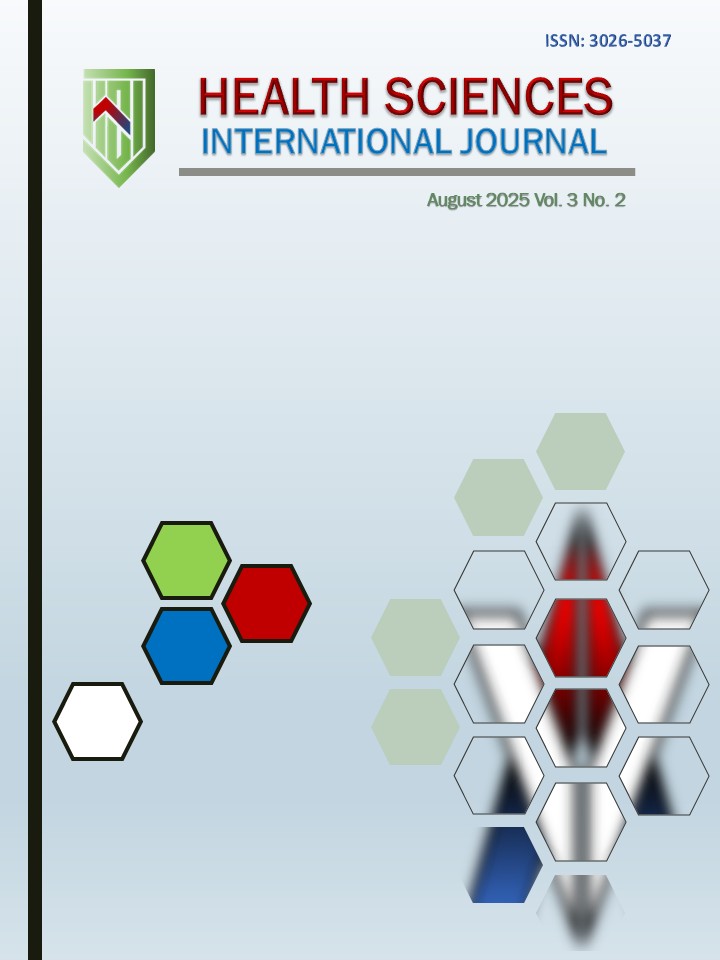Birth history as a predictor of stunting incidence among toddlers
DOI:
https://doi.org/10.71357/hsij.v3i2.75Keywords:
Stunting, Birth length, Birth weight, Birth age, Perinatal determinantsAbstract
Background: Stunting remains a critical public health challenge in Indonesia, with a national prevalence of 21.6%, reflecting long-term nutritional deprivation and irreversible developmental impairments. Despite lower stunting rates (4.3%) at Pemurus Baru Community Health Center, local disparities persist, necessitating investigation into perinatal determinants like birth weight, length, and gestational age, which may establish biological pathways to stunting.
Objective: This study aimed to analyze the association between adverse birth history and stunting incidence among toddlers aged 12–60 months.
Methods: A case-control design was employed, retrospectively comparing 63 stunted children (cases) with 63 non-stunted controls matched by age and location. Data were extracted from perinatal records (2019–2023) and analyzed for birth weight, length, and preterm status.
Results: The study revealed significant differences in birth history between stunted and non-stunted toddlers. The case group showed higher prevalence of low birth weight (36.5% vs 12.7%), short birth length (60.3% vs 39.1%), and preterm birth (36.5% vs 14.3%) compared to controls. All three birth parameters demonstrated substantial disparities between groups, with the case group consistently exhibiting worse outcomes across all measured indicators.
Conclusion: Intrauterine growth restriction, maternal malnutrition, and premature delivery are stronger predictors of stunting than postnatal factors alone. Prevention strategies must prioritize early interventions during the first 1,000 days, including prenatal nutritional supplementation and fetal growth monitoring, supported by policy reforms integrating birth history into surveillance systems.
Downloads
References
Akmal, I. P., Safitri, D. E., & Fitriani, A. (2024). The factors that affect LBW in developing countries: Systematic literature review. Arsip Keilmuan Gizi (AKG), 1(1), 42–66. https://doi.org/10.36590/akg.v1i1.817
Amareta, D. I., Palestin, C. N., & Lestari, A. D. (2022). LBW incidence based on socio-economic, Hb level and compliance of pregnant women taking Fe supplements. Bali Medical Journal, 11(2), 697–701. https://doi.org/10.15562/bmj.v11i2.3139
D’Agostin, M., Di Sipio Morgia, C., Vento, G., & Nobile, S. (2023). Long-term implications of fetal growth restriction. World Journal of Clinical Cases, 11(13), 2855–2863. https://doi.org/10.12998/wjcc.v11.i13.2855
Etzel, R. A. (2020). Is the environment associated with preterm birth? JAMA Network Open, 3(4), e202239. https://doi.org/10.1001/jamanetworkopen.2020.2239
Fitri J, R., Huljannah, N., & Rochmah, T. N. (2022). Stunting prevention program in Indonesia: A Systematic Review. Media Gizi Indonesia, 17(3), 281–292. https://doi.org/10.20473/mgi.v17i3.281-292
Gaillard, R., Steegers, E. A., de Jongste, J. C., Hofman, A., & Jaddoe, V. W. (2014). Tracking of fetal growth characteristics during different trimesters and the risks of adverse birth outcomes. International Journal of Epidemiology, 43(4), 1140–1153. https://doi.org/10.1093/ije/dyu036
Garcia-Flores, V., Romero, R., Furcron, A.-E., Levenson, D., Galaz, J., Zou, C., Hassan, S. S., Hsu, C.-D., Olson, D., Metz, G. A. S., & Gomez-Lopez, N. (2020). Prenatal maternal stress causes preterm birth and affects neonatal adaptive immunity in mice. Frontiers in Immunology, 11. https://doi.org/10.3389/fimmu.2020.00254
Gordijn, S. J., Beune, I. M., Thilaganathan, B., Papageorghiou, A., Baschat, A. A., Baker, P. N., Silver, R. M., Wynia, K., & Ganzevoort, W. (2016). Consensus definition of fetal growth restriction: a Delphi procedure. Ultrasound in Obstetrics & Gynecology, 48(3), 333–339. https://doi.org/10.1002/uog.15884
Henderson, J., Carson, C., & Redshaw, M. (2016). Impact of preterm birth on maternal well-being and women’s perceptions of their baby: a population-based survey. BMJ Open, 6(10), e012676. https://doi.org/10.1136/bmjopen-2016-012676
Institute of Medicine (US) Committee on understanding premature birth and assuring healthy outcomes. (2007). Preterm birth: Causes, consequences, and prevention. In R. E. Behrman & A. S. Butler (Eds.), Mortality and Acute Complications in Preterm Infants. National Academies Press. https://www.ncbi.nlm.nih.gov/books/NBK11385/
Lees, C. C., Stampalija, T., Baschat, A. A., da Silva Costa, F., Ferrazzi, E., Figueras, F., Hecher, K., Kingdom, J., Poon, L. C., Salomon, L. J., & Unterscheider, J. (2020). ISUOG Practice guidelines: Diagnosis and management of small‐for‐gestational‐age fetus and fetal growth restriction. Ultrasound in Obstetrics & Gynecology, 56(2), 298–312. https://doi.org/10.1002/uog.22134
Leyto, S. M., & Mare, K. U. (2022). Association of placental parameters with low birth weight among neonates born in the Public Hospitals of Hadiya Zone, Southern Ethiopia: An institution-based cross-sectional study. International Journal of General Medicine, 15, 5005–5014. https://doi.org/10.2147/IJGM.S354909
Ministry of Health - Republic of Indonesia. (2020). Basic health research 2020: National report. Jakarta: Ministry of Health - Republic of Indonesia.
Ministry of Health - Republic of Indonesia. (2023). Stunting in Indonesia and Its Determinants [in Indonesia}. Jakarta: Ministry of Health - Republic of Indonesia.
Ministry of Health- Republic of Indonesia. (2021). Pocket Book - Results of the Indonesian Nutritional Status Study at the national, provincial, and district/city levels, year 2021 [in Indonesia]. Jakarta: Ministry of Health - Republic of Indonesia. https://www.badankebijakan.kemkes.go.id/buku-saku-hasil-studi-status-gizi-indonesia-ssgi-tahun-2021/
Möllers, L. S., Yousuf, E. I., Hamatschek, C., Morrison, K. M., Hermanussen, M., Fusch, C., & Rochow, N. (2022). Metabolic-endocrine disruption due to preterm birth impacts growth, body composition, and neonatal outcome. Pediatric Research, 91(6), 1350–1360. https://doi.org/10.1038/s41390-021-01566-8
Mwangome, M., Ngari, M., Brals, D., Bawhere, P., Kabore, P., McGrath, M., & Berkley, J. A. (2024). Stunting in the first year of life: Pathway analysis of a birth cohort. PLOS Global Public Health, 4(2), e0002908. https://doi.org/10.1371/journal.pgph.0002908
National Academies of Sciences, E. and M. H. and M. D. B. on H. C. S. C. on the I. and P. of L. B. W. B. in D. D. (2024). Health conditions and impairments associated with low birth weight and their functional implications. In A. Applegate, C. M. Spicer, & Frontera W (Eds.), Low birth weight babies and disability. National Academies Press. https://www.ncbi.nlm.nih.gov/books/NBK605571/
Nkwabong, E., Kamgnia Nounemi, N., Sando, Z., Mbu, R. E., & Mbede, J. (2015). Risk factors and placental histopathological findings of term born low birth weight neonates. Placenta, 36(2), 138–141. https://doi.org/10.1016/j.placenta.2014.12.005
Oke, O., Salibi, G., & Tzenios, N. (2024). Effects of pre-pregnancy maternal underweight on pregnancy and perinatal outcomes of the foetus. Special Journal of the Medical Academy and Other Life Sciences, 2(7). https://doi.org/10.58676/sjmas.v2i7.81
Patel, H., Mehta, J., Patel, B., Ram, R., & Rathod, M. (2023). An institutional based cross sectional analytical study on nutritional determinants of low birth weight. International Journal of Innovative Research in Medical Science, 8(06), 202–208. https://doi.org/10.23958/ijirms/vol08-i06/1692
Pike, K., Jane Pillow, J., & Lucas, J. S. (2012). Long term respiratory consequences of intrauterine growth restriction. Seminars in Fetal and Neonatal Medicine, 17(2), 92–98. https://doi.org/10.1016/j.siny.2012.01.003
Sana, I. S., Khan, S. A., Hussain, S., Ur Rehman, M., & Adnan, M. S. (2025). Maternal nutrition and its impact on low birth weight in newborns. Indus Journal of Bioscience Research, 3(1), 236–244. https://doi.org/10.70749/ijbr.v3i1.482
Sharma, M., Bhatia, J. K., & Malik, A. (2021). A clinicopathologic study of placentae of low birth weight and normal birth weight babies born at a tertiary care center in western India. Medical Journal of Dr. D.Y. Patil Vidyapeeth, 14(2), 166–171. https://doi.org/10.4103/mjdrdypu.mjdrdypu_179_20
Thompson, R. A. (2024). Early brain development and public health. Delaware Journal of Public Health, 10(4), 6–11. https://doi.org/10.32481/djph.2024.10.03
Trisnawati, I., Salimo, H., & Murti, B. (2018). Low birthweight and its biopsychosocial and economic determinants: A new evidence using a path analysis model from Jambi, South Sumatera. Revitalizing Family Planning Program and Women’s Empowerment for the Improvement of Population Well-Being and Economic Development, 169–169. https://doi.org/10.26911/mid.icph.2018.03.05
UNICEF, & WHO. (2019). UNICEF-WHO Low birthweight estimates: Levels and trends 2000–2015. World Health Organization.
Westby, A., & Miller, L. (2021). Fetal growth restriction before and after birth. American Family Physician, 104(5), 486–492.
WHO. (2018). Reducing stunting in children: Equity considerations for achieving the Global Nutrition Targets 2025. WHO.
WHO-UNICEF-World Bank Group. (2023). Levels and trends in child malnutrition: UNICEF/WHO/World Bank Group joint child malnutrition estimates: Key findings of the 2023 edition. WHO-UNICEF-World Bank Group.
Downloads
Published
Issue
Section
License
Copyright (c) 2025 Afrina Aulia Sari, Adriana Palimbo, Novalia Widiya Ningrum, Desilestia Dwi Salmarini, Raudhatul Jannah

This work is licensed under a Creative Commons Attribution-ShareAlike 4.0 International License.
Health Sciences International Journal (HSIJ) © 2023 by Ananda Health and Education Foundation is licensed under Attribution-ShareAlike 4.0 International







